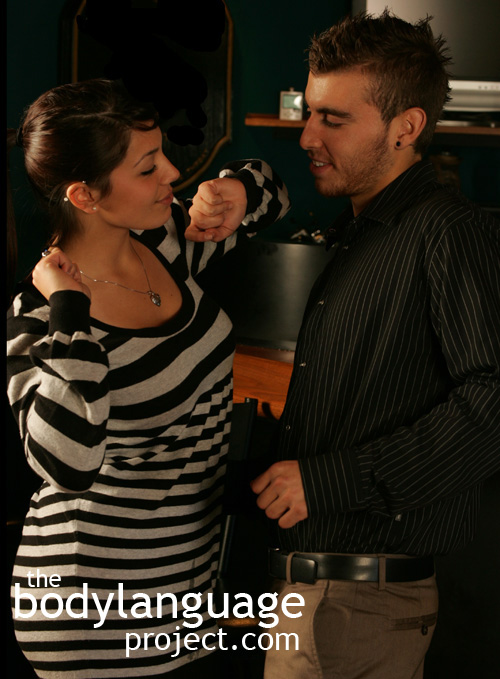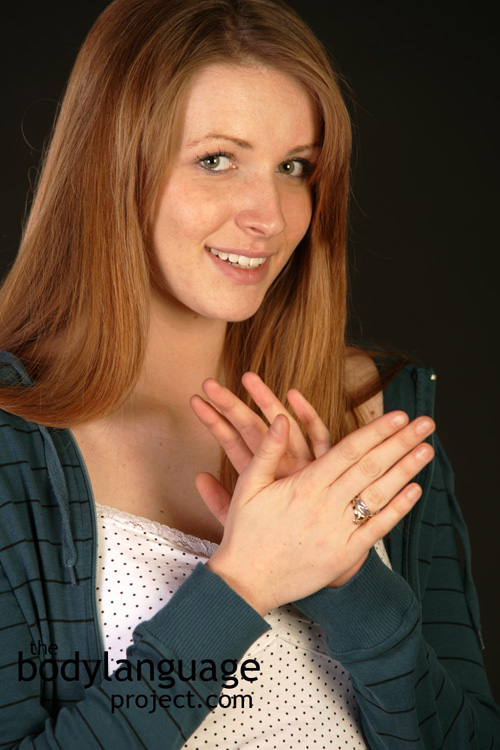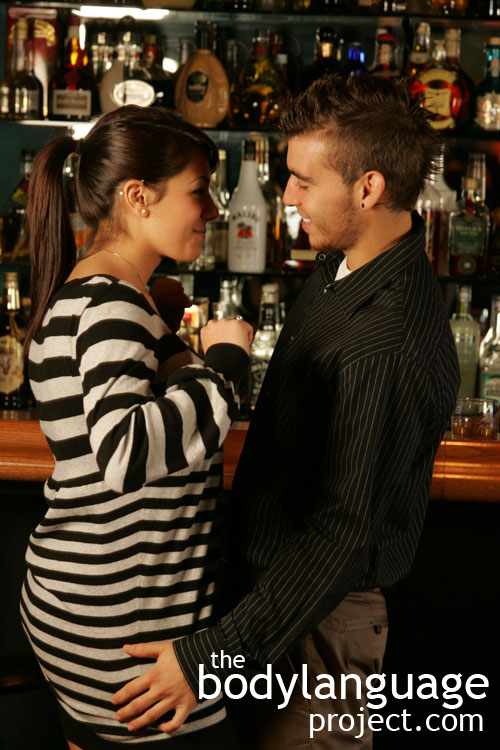The Hidden Meaning Baton Gestures Or Hand Chop Gesture Body Language
 Cue: Baton Gestures
Cue: Baton Gestures
Synonym(s): Hand Chop Gesture, Power Grip, Thumb In Hand Gesture.
Description: A motion done with the hands to emphasize points in speech sometimes in rhythm with each word. It is made by balling up the fist and repeatedly and rhythmically batoning it against the palm of the other hand, or the table, as an axe would fall against a log.
In One Sentence: Batoning is a gesture done by moving the hand up and down in conjunction with speech – usually important points in speech.
How To Use it: Batoning is effectively used when addressing a crowd as it can provide emphasis to certain key words or ideas. By moving the hand up and down with each important point it serves to ‘drive the point home.’ Imagine the hand like the head of a hammer coming down as ideas are expressed. Use batoning when you want to show passion, be it in business, or in debate amongst friends.
Context: Business or General
Verbal Translation: “I’m going to hammer my point home by beating it into your brain… one, word, at, a, time!”
Variant: The hand might be palm down, or palm vertical, or balled into a fist.
Cue In Action: Bill Clinton made the batoning motion famous as he emphasized nearly each word in his denial speech against his involvement with Monica Lewinsky “I did not, have, sexual, relations, with, that, women.” as his arm pumped up and down.
Other examples include Adolf Hitler as he gestured his followers into submission and television evangelists who forcefully hammer their words onto others.
Meaning and/or Motivation: The thumb in hand or baton gesture is the “politicians gesture” since it is frequently used by various presidents and world leaders and is a less offensive way to accomplish what would otherwise be left to finger pointing.
It is designed to be a conversation ender – to be the last word spoken. It is highly authoritative in effort to add emphasis to a thought or idea. A baton or chop adds emotion to the words it is attached to. It is habitually done by powerful people who have the floor and are in charge. A person using a power grip wants to appear strong, serious, and forceful.
The type of illustrators used vary by culture and also vary in frequency. Latin cultures for example, will use more illustrators than Anglo-Saxon cultures, and they in turn, use more than Asian cultures. In business, the differences between cultures are especially important since Asian cultures might see the use of illustrators as a lack of intelligence if used too frequently and in Latin cultures it might be construed as a lack of interest or involvement to use too few.
Cue Cluster: The baton gesture is usually coupled with other authoritative and leadership body language such as a booming voice to further emphasize words, sprawled and expansive movements and other open and dominant body language.
Body Language Category: Illustrator, Palm power, Leadership body language, Enthusiasm (nonverbal), Authoritative body language, Gesticulation.
Resources:
Austin, Elizabeth E. and Naomi Sweller. Presentation and Production: The Role of Gesture in Spatial Communication. Journal of Experimental Child Psychology. 2014. 122: 92-103.
http://bodylanguageproject.com/articles/gestures-help-children-but-not-adults-in-recall-study/
Alibali, M.W., Heath, D.C., and Myers,H.J. (2001). Effects of visibility between speaker and listener on gesture production: Some gestures are meant to be seen. Journal of Memory and Language, 44, 169–188.
Andric, Michael ; Solodkin, Ana ; Buccino, Giovanni ; Goldin-Meadow, Susan ; Rizzolatti, Giacomo ; Small, Steven L. Brain function overlaps when people observe emblems, speech, and grasping. Neuropsychologia, 2013, Vol.51(8), pp.1619-1629
Beattie, G., & Shovelton,H.(1999). Mapping the range of information contained in the iconich and gestures that accompany spontaneous speech. Journal of Language and social Psychology, 18, 438–462.
Biau, E., & Soto-Faraco, S.(2013). Beat gestures modulate auditory integration in speech perception. Brain and Language, 124(2), 143–152.
Bartolo, A.,Cubelli,R.,DellaSala,S.,&Drei,S.(2003).Pantomimes are special gestures which rely on working memory. Brain and Cognition, 53, 483–494.
Bernardis, P.,& Gentilucci,M.(2006).Speec hand gestures are the same communication system. Neuropsychologia, 44, 178–190.
Buccino, G.,Vogt,S., Ritzl, A., Fink, G .R., Zilles, K., Freund, H. J., et al.(2004).Neural circuits underlying imitation learning of hand actions: Anevent-related fMRI study. Neuron, 42, 323–334.
Bailenson, J. N. & Yee, N. 2005. Digital Chameleons: Automatic assimilation of nonverbal gestures in immersive virtual environments. Psychological Science, 16: 814-819.
Cook, Susan Wagner; Terina KuangYi Yip and Susan Goldin-Meadow. Gesturing Makes Memories That Last. Journal of Memory and Language. 2010. 63: 465-475.
http://bodylanguageproject.com/articles/gesturing-really-work-improve-memory
Chandler, Jesse ; Schwarz, Norbert. How extending your middle finger affects your perception of others: Learned movements influence concept accessibility. Journal of Experimental Social Psychology. 2009. 45(1): 123-128.
http://bodylanguageproject.com/articles/how-extending-the-middle-finger-affects-perception/
Dick, A.S., Goldin-Meadow,S., Hasson,U.,Skipper, J.I., & Small, S.L. (2009). Co- speech gestures influence neural activity in brain regions associated with processing semantic information. Human Brain Mapping, 30, 3509–3526.
Ekman, Paul ; Friesen, Wallace V. ; O’sullivan, Maureen ; Chan, Anthony ; Diacoyanni-tarlatzis, Irene ; Heider, Karl ; Krause, Rainer ; Lecompte, William Ayhan ; Pitcairn, Tom ; Ricci-bitti, Pio E. ; Scherer, Klaus ; Tomita, Masatoshi ; Tzavaras, Athanase. Universals and Cultural Differences in the Judgments of Facial Expressions of Emotion
Journal of Personality and Social Psychology. 1987. 53(4): 712-717.
Ekman, Paul ; Friesen, Wallace V. ; O’sullivan, Maureen ; Chan, Anthony ; Diacoyanni-tarlatzis, Irene ; Heider, Karl ; Krause, Rainer ; Lecompte, William Ayhan ; Pitcairn, Tom ; Ricci-bitti, Pio E. ; Scherer, Klaus ; Tomita, Masatoshi ; Tzavaras, Athanase. Universals and Cultural Differences in the Judgments of Facial Expressions of Emotion
Journal of Personality and Social Psychology. 1987. 53(4): 712-717.
Fischer, Julia; Peter Fischer; Birte Englich; Nilüfer Aydin and Dieter Frey. Empower My Decisions: The Effects of Power Gestures on Confirmatory Information Processing. Journal of Experimental Social Psychology. 2011. 47: 1146-1154.
http://bodylanguageproject.com/articles/downside-power-posing-body-language-looking-power-posing-action-study/
Fabbri-Destro, M.,& Rizzolatti,G. (2008). Mirror neurons and mirror systems in monkeys and humans. Physiology, 23, 171–179.
Fogassi, L., Gallese,V., Fadiga,L., & Rizzolatti,G. (1998). Neurons responding to the sight of goal directed hand/armactions in the parietal area PF (7b) of the macaque monkey. Society for Neuroscience, 24, 257.5.
Fusaro, M., Harris, P. L., & Pan, B. A. (2012). Head nodding and head shaking gestures in children’s early communication. First Language, 32, 439–458. doi:10.1177/0142723711419326
Gentilucci, M., Bernardis, P., Crisi,G., & Dalla Volta, R. (2006). Repetitive transcranial magnetic stimulation of Broca’s area affects verbal responses to gesture observation. Journal of Cognitive Neuroscience, 18, 1059–1074.
Goldin-Meadow, S. (1999).The role of gesture in communication and thinking. Trends in Cognitive Sciences, 3, 419–429.
Goldin-Meadow, S.(2003). Hearing gesture: How our hands help us think. Cam-bridge, MA: Belknap Press of Harvard University Press.
Gräfenhain, M., Behne, T., Carpenter, M., & Tomasello, M. (2009). One-year-olds’ understanding of nonverbal gestures directed to a third person. Cognitive Development, 24, 23–33. doi:10.1016/j.cogdev.2008.10.001
Guidetti, M. (2005). Yes or no? How do young children combine gestures and words to agree and refuse. Journal of Child Language, 32, 911–924. doi:10.1017/S0305000905007038
Gorkan Ahmetoglu, Viren Swami. Do Women Prefer “Nice Guys?” The Effect Of Male Dominance Behavior On Women’s Ratings. Social Behavior And Personality, 2012; 40(4), 667-672.
http://bodylanguageproject.com/articles/how-to-significantly-increase-male-attractiveness-with-simple-body-language-nice-guys-finish-last-once-again/
Goldin-Meadow, Susan; Susan Wagner Cook, and Zachary A. Mitchell. Gesturing Gives Children New Ideas About Math. Association for Psychological Science. 2009. 20 (3): 267-272.
http://bodylanguageproject.com/articles/gesturing-helps-children-learn-math/
Goldin-Meadow, S. Widening The Lens: What The Manual Modality Reveals About Language, Learning and Cognition. Philosophical Transactions of the Royal Society B: Biological Sciences. 2014; 369-1651. 20130295 DOI: 10.1098/rstb.2013.0295
http://bodylanguageproject.com/articles/spontaneous-hand-gestures-help-children-learn-study/
Holle, H., & Gunter,T.C. (2007). The role of iconic gestures in speech disambiguation: ERP evidence. Journal of Cognitive Neuroscience, 19, 1175–1192.
Holler, J., Shovelton, H.,& Beattie, G.(2009).Do iconic hand gestures really contribute to the communication of semantic information in a face-to-face context? Journal of Nonverbal Behavior, 33, 73–88.
Hubbard, A.L., Wilson, S. M., Callan, D. E., & Dapretto, M.(2009).Giving speech a hand: Gesture modulates activity in auditory cortex during speech perception. Human Brain Mapping, 30, 1028–1037.
Hubbard, A.L., Wilson,S.M., Callan,D.E., & Dapretto, M.(2009). Giving speech a hand: Gesture modulates activity in auditory cortex during speech perception. Human Brain Mapping, 30, 1028–1037.
He, Yifei ; Gebhardt, Helge ; Steines, Miriam ; Sammer, Gebhard ; Kircher, Tilo ; Nagels, Arne ; Straube, Benjamin. The EEG and fMRI signatures of neural integration: An investigation of meaningful gestures and corresponding speech. Neuropsychologia. 2015. 72: 27-42.
Hansen, Jacqueline. Teaching without talking: teachers need to be aware of more than just the words they speak to children. They also need to monitor the nonverbal messages that they’re sending to students through proximity, eye contact, gestures, and touching. Phi Delta Kappan. 2010. 92(1): 35(6).
Holle, H., & Gunter,T.C. (2007). The role of iconic gestures in speech disambiguation: ERP evidence. Journal of Cognitive Neuroscience, 19, 1175–1192.
Holler, J., Shovelton, H.,& Beattie, G.(2009).Do iconic hand gestures really contribute to the communication of semantic information in a face-to-face context? Journal of Nonverbal Behavior, 33, 73–88.
Hubbard, A.L., Wilson, S. M., Callan, D. E., & Dapretto, M.(2009).Giving speech a hand: Gesture modulates activity in auditory cortex during speech perception. Human Brain Mapping, 30, 1028–1037.
Kelly, S. D., Barr, D. J., Church, R. B., & Lynch, K.(1999).Offering a hand topragmatic understanding: The role of speech and gesture in comprehension and memory. Journal of Memory and Language, 40, 577–592.
Kelly, S. D., Creigh, P., & Bartolotti, J.(2009).Integrating speech and iconic gestures in a Stroop-like task: Evidence for automatic processing. Journal of Cognitive Neuroscience, 22, 683–694.
Kelly, S.D., Kravitz, C.,& Hopkins, M.(2004).Neural correlates of bimodal speech and gesture comprehension. Brain and Language, 89(1), 253–260.
Krahmer,E., & Swerts, M.(2007).The effects of visual beats on prosodic prominence: Acoustic analyses, auditory perception and visual perception. Journal of Memory and Language, 57, 396–414.
Krauss, R. M., Dushay, R.A., Chen,Y., & Rauscher, F.(1995).The communicative value of conversational hand gesture. Journal of Experimental Social Psychology, 31(6), 533–552.
Kendon,A.(1994).Do gestures communicate? A review. Research on Language and Social Interaction, 27, 175–200.
Knutson, K.M., McClellan,E.M., & Grafman, J.(2008).Observing social gestures: An fMRI study. Experimental Brain Research, 188, 187–198.
Kelly, S. D., Barr, D. J., Church, R. B., & Lynch, K.(1999).Offering a hand topragmatic understanding: The role of speech and gesture in comprehension and memory. Journal of Memory and Language, 40, 577–592.
Leonard, T., & Cummins, F.(2010).The temporal relation between beat gestures and speech. Language and Cognitive Processes, 26, 1457–1471.
Lindenberg, R., Uhlig,M., Scherfeld,D., Schlaug,G., & Seitz, R.J.(2012).Commu- nication with emblematic gestures: Shared and distinct neural correlates of expression and reception. Human Brain Mapping, 33, 812–823.
Montgomery, K.J., Isenberg, N., & Haxby,J.V. (2007). Communicative hand gestures and object-directed hand movements activated the mirror neuron system. Social Cognitive and Affective Neuroscience, 2, 114–122.
Molnar-Szakacs, Istvan ; Wu, Allan D ; Robles, Francisco J ; Iacoboni, Marco Robertson, Edwin (Academic Editor). Do You See What I Mean? Corticospinal Excitability During Observation of Culture-Specific Gestures (Gesture Perception). PLoS ONE. 2007. 2(7): p.e626
Ohgami, Y., Matsuo,K., Uchida,N., & Nakai,T. (2004). An fMRI study of tool-use gestures: Body partas object and pantomime. Neuroreport, 15, 1903–1906.
Parrill, F. and I. Kimbara. 2006. Seeing and hearing double: the influence of mimicry in speech and gesture on observers. Journal of Nonverbal Behavior 30(4): 157-166.
Renninger, Lee Ann; T. Joel Wade, Karl Grammer. Getting that female glance: Patterns and consequences of male nonverbal behavior in courtship contexts. Evolution and Human Behavior. 2004; 25: 416–431.
http://bodylanguageproject.com/articles/part-i-how-to-read-male-sexual-body-language-a-study-for-women-and-the-men-who-wish-to-cheat-the-system/
Singer, Melissa A. and Susan Goldin-Meadow. Children Learn When Their Teacher’s Gestures and Speech Differ. American Psychological Society. 2005. 16(2): 85-89.
http://bodylanguageproject.com/articles/children-learn-better-when-teachers-use-gesture/
Simone, Pika; Nicoladis, Elena; Marentette, Paula, F. A cross-cultural study on the use of gestures: Evidence for cross-linguistic transfer? Bilingualism Language and Cognition. 9(3): 319 -327
Sun Jung, Hyo Sun and Hye Hyun Yoon. The Effects of Nonverbal Communication of Employees in the Family Restaurant Upon Customers’ Emotional Responses and Customer Satisfaction. International Journal of Hospitality Management. 2011. 30: 542-550.
http://bodylanguageproject.com/articles/effect-body-languagel-cues-family-restaurant/
Skipper, J.I., Goldin-Meadow, S., Nusbaum,H.C.,& Small,S.L. (2007).Speech- associated gestures, Broca’s area, and the human mirror system. Brain and Language, 101, 260–277.
Sherzer, Joel The Brazilian Thumbs-Up Gesture. Journal of Linguistic Anthropology, 1991, Vol.1(2), pp.189-197
Straube,B., Green,A., Bromberger,B., & Kircher, T. (2011).The differentiation of iconic and metaphoric gestures: Common and unique integration processes. Human Brain Mapping, 32, 520–533.
Straube, Benjamin ; Green, Antonia ; Jansen, Andreas ; Chatterjee, Anjan ; Kircher, Tilo. Social cues, mentalizing and the neural processing of speech accompanied by gestures. Neuropsychologia. 2010. 48(2): 382-393.
Teixeira Fiquer, Juliana; Paulo Sérgio Boggio and Clarice Gorenstein. Talking Bodies: Nonverbal Behavior in the Assessment of Depression Severity. Journal of Affective Disorders. 2013. 150: 1114-1119.
http://bodylanguageproject.com/articles/using-nonverbal-behaviour-to-assess-depression-severity/
Wu, Y. C., & Coulson, S.(2005).Meaningful gestures: Electrophysiological indices of iconic gesture comprehension. Psychophysiology, 42, 654–667.
Wang, Lin ; Chu, Mingyuan Neuropsychologia. The role of beat gesture and pitch accent in semantic processing: An ERP study. 2013, Vol.51(13), pp.2847-2855
Willems, R.M., Ozyurek,A., & Hagoort,P.(2007).When language meets action:The neural integration of gesture and speech. CerebralCortex, 17, 2322–2333.
Xu,J., Gannon,P.J., Emmorey,K., Smith,J.F., & Braun,A.(2009). Symbolic gestures and spoken language are processed by a common neural system. Proceedings of the NationalAcademyofSciences, 106, 20664–20669.
 Cue: Double Gripper Politician Handshake
Cue: Double Gripper Politician Handshake



